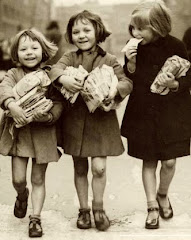While it appears that some people don’t like David Almond’s novel Skellig, I thought it was a lovely story that left me wanting more. The text seemed a little slow at first, but once Mina and Michael are brought deeper and deeper into contact with Skellig and Michael’s sister’s life is placed in greater danger, I found myself enjoying the story and relationships between the characters. I enjoyed Almond’s use of William Blake’s poems and images to create a creature who teaches Michael and Mina the power of faith and love by giving them wings of their own.
What I thought was interesting in the text were the similarities between Skellig and Michael’s baby sister. Both are described as having pale white skin and black hair and they both are near death. It is only through care from Michael and Mina that Skellig becomes strong enough to recover on his own and it is only through the care of the doctors at the hospital and the positive thoughts of Michael and his family that the baby is able to survive her premature birth. It is as if the two of them are connected by their angel-like characteristics and their need for care in order to survive.
Perhaps my favorite part of the book was when Mina taught Michael to listen deeply to the night around them. From that moment on, Michael is able to deep listen for the thing that means the most to him; his baby sister—especially her heart. Michael says, “I listened through all these noises, until I heard the baby, the gentle squeaking of her breath, tiny and distant like it came from a different world….I listened deeper, until I believed I heard her beating heart” (96). From that moment on, he connects the beating of his own heart to that of his sister’s, “I touched my heart and I felt the baby’s heart beating beside my own” (97). This feeling carries on through the rest of the book and Michael fears the worse when he can no longer feel the her heart beating with his.
When it comes to love, Michael and Mina learn that they can help heal Skellig through their love of him—love that transfers into care. Likewise, the love and care received by Michael’s sister helps her grow strong and live. Michael asks a doctor at the hospital if love can heal people to which the doctor replies, “‘Love is the child that breathes our breath/Love is the child that scatters death,’” a quote from William Blake. The reference to Blake links back to the image of angels and, thus, Skellig. The line also suggests that love is a part of us—like our own child—and that the existence of love can overpower death.
Love is a powerful and—in this context—innocent creation that links the ability of Skellig to give the children wings and teach them to fly. In the book, there are several instances in which shoulder blades are connected with angels. Michael’s mother says, “They say shoulder blades are where your wings were, when you were an angel….They say they’re where your wings will grow again one day” (38-39). Angels are typically associated with innocence, children, and guardianship and the relationship between Michael, Mina, and Skellig reflects this. I believe these connections partially explain the ability of Skellig to give Michael, Mina, and Michael’s baby sister the brief ability to fly. The strong loving relationship between them allows Skellig to give the children a taste of the angelic life they might have once known and will someday know again.
When it comes to the baby girl in the story, I think it is powerful that Almond decided not to give her a name until the very end of the story. During the text Michael is told the myth of Persephone and how she comes back from the underworld every year. Michael thinks a lot about this myth and connects it to his sister. It’s is as if he wants her to be a strong as Persephone in fighting to make it in the world. He even suggests naming her Persephone but the family ultimately decides upon Joy, and that is what she is to the family.
Almond’s novel both excited me and confused me. I liked the premise of the story and the characters themselves, but I want to know more about Skellig; what is he, why is he there, why was he in such a state when Michael found him, etc. When I finished the book I felt not completely satisfied and with these questions still ringing in my mind. While I can try and make connections between the text and my prior knowledge of Blake and angels, I think it would take another reading to get try and make more deductions from the text and possibly satisfy my curiosity. Like I said, I wanted more!
I admit that Almond does a great job in weaving a story that is dynamic and engaging and I loved Skellig’s somewhat harsh personality and its dichotomy to the typical imaginative supposition of what an angel is. Almond leaves the reader guessing whether or not Skellig really is an angel or if he is an otherworldly creature with mystical healing powers—something I didn’t really like, but some might like the mystery surrounding such a strange character. I think students would really enjoy the reading this story and the intriguing characteristics of the people in Michael’s life from the enigmatic Mina, the crass Coot and Leakey, to Michael’s innocent baby sister, Joy.
Subscribe to:
Post Comments (Atom)

This is a beautiful reflection of the book. You are an incredibly eloquent writer. Great work, Mer!
ReplyDelete